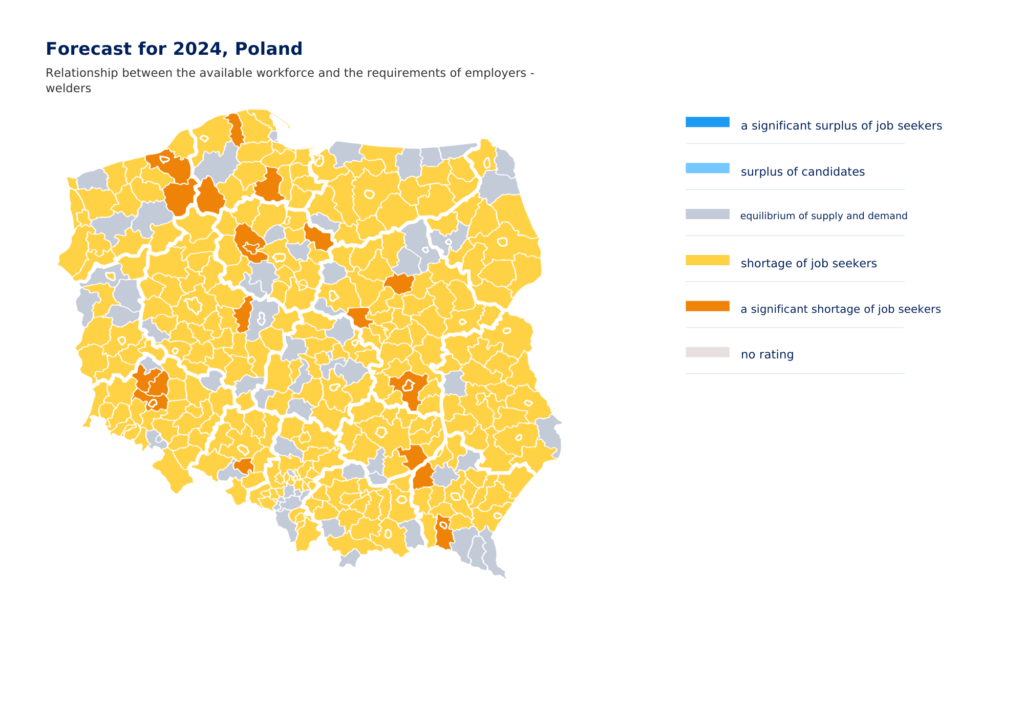The profession of a welder, especially in MAG and TIG methods, is currently in high demand in Poland and Europe. The increase in industrial and construction investments, along with extensive infrastructure projects, has led to a greater need for skilled welders, which is reflected in their salaries.
In this article, we will take a detailed look at how much MAG and TIG welders earn in Poland and European countries such as Germany, Austria, the Netherlands, and Scandinavia. We will also discuss which industries offer the highest salaries. We invite you to check out the latest job offers on our website.
Salaries of MAG and TIG Welders in 2024 – Poland and Europe
Wages for MAG and TIG welders vary significantly depending on the country, experience, and employment sector.
Poland
In Poland, salaries for welders using MAG technology start at 4,000 PLN per month and can reach 5,500 PLN for more advanced positions. TIG welders, who work in sectors requiring precision, can earn from 6,500 PLN to 7,783 PLN net. Notably, welder wages in Poland have risen by about 20-30% since 2018, driven by growing demand for specialists and changes in the labor market.

Germany
In Germany, wages for MAG welders start at 18 EUR gross per hour, with experienced welders earning up to 25-35 EUR per hour in sectors that require additional skills, such as heavy industry or offshore. TIG welder rates are generally higher – ranging from 25-30 EUR gross per hour, with rates in demanding sectors like the chemical industry reaching up to 40 EUR per hour.
The Netherlands
In the Netherlands, average wages for MAG welders range from 15-18 EUR gross per hour, while TIG welders earn 20-30 EUR in specialist fields, such as construction projects and the food industry. Welders with extensive experience, particularly in offshore sectors, can earn over 30 EUR per hour.
Austria and Scandinavia
In Austria, MAG welders earn between 17-20 EUR gross per hour, while TIG rates can reach 25 EUR per hour. In Scandinavia – especially in Norway – TIG and MAG welders’ salaries start at 25 EUR and can reach 40-45 EUR per hour for specialists working offshore, due to challenging work conditions and high technical requirements.
MAG or TIG – Which Method Is More Profitable?
TIG Method
The TIG (Tungsten Inert Gas) method is more demanding and precise, making it preferred in industries with high-quality standards. TIG welder salaries are typically higher, and the best-paid sectors include:
- Offshore and Underwater Work: TIG specialists in this field, especially in Scandinavia, earn up to 40-45 EUR per hour, due to specific technical requirements and working conditions.
- Food and Chemical Industry: The TIG method is favored in sectors that require welding stainless and acid-resistant steels. In countries like Germany and the Netherlands, TIG welders can earn from 25 to 30 EUR per hour.
- Precision Manufacturing: Manufacturing industries that demand precision often prefer the TIG method, offering rates of 20-25 EUR gross per hour.
MAG Method
MAG (Metal Active Gas) welding is popular in construction and steel structures, where the strength of the weld and work efficiency are essential. In these sectors, salaries are usually lower than those for TIG, but MAG still offers stable employment opportunities.
- Steel Structures: MAG welders in Germany typically earn 18-25 EUR per hour, while in Poland, wages range from 4,000 to 5,500 PLN per month.
- Machine Production and Infrastructure: In the Netherlands and Germany, wages for MAG welders range from 15 to 20 EUR per hour, appealing to those who prefer larger-scale projects.
Benefits for Welders and Their Impact on Salaries
Due to the high demand for skilled welders, many employers in Poland and Europe offer additional benefits that can significantly increase overall compensation. These perks are especially attractive in countries like Germany, the Netherlands, or Norway, where living costs are high. According to the 2024 Occupational Barometer, extra benefits have become a standard feature in many job offers for welders, particularly in specialized fields like offshore or underwater work.
Typical Benefits
Employers offer various benefits aimed at attracting and retaining top talent:
- Accommodation and Transport: In offshore or international projects, employers often provide free accommodation and transport to the work site, which effectively reduces living costs, increasing the real value of wages.
- Private Healthcare: Many employers offer access to private medical care, which is an attractive perk, especially in countries where healthcare costs are high.
- Sports Passes and Recreation Subscriptions: Gym memberships, swimming pool passes, or sports courses are popular perks that contribute to employee well-being, improving health and job satisfaction.
- Hardship Allowances: In offshore or underwater sectors, additional bonuses for working in difficult conditions can amount to 20-30% of wages, making work in these fields very profitable.
These benefits and perks are an important factor when choosing a job offer, as they not only increase real earnings but also improve the quality of life for workers.
Summary: How Much Does a Welder Earn in 2024?
TIG welders typically earn more than MAG specialists, especially in offshore industries and sectors requiring precision welds, such as the food or chemical industries. Key takeaways:
- TIG: Higher earnings in offshore, food, and chemical industries; rates often exceed 30 EUR per hour in Scandinavia and Germany.
- MAG: Popular in steel construction and machine production, offering more stable but lower wages – from 15 to 25 EUR in Western Europe.
The welding profession, though demanding, offers the opportunity for attractive earnings, especially for those who have obtained high qualifications and are willing to work in challenging conditions.
The Impact of Benefits on Overall Compensation
Perks and benefits can increase a worker’s total compensation by 20-40%. For example, welders working offshore with free accommodation and hardship bonuses earn 30-40% more than those working onshore. Thanks to these benefits, the total value of employment for welders in Norway or Germany can reach the equivalent of 40-50 EUR net per hour, even if the hourly rates themselves are 25-35 EUR gross.
Want to compare your salary to market rates?
Use the salary meter: Salary Survey – PensjoMetr.



